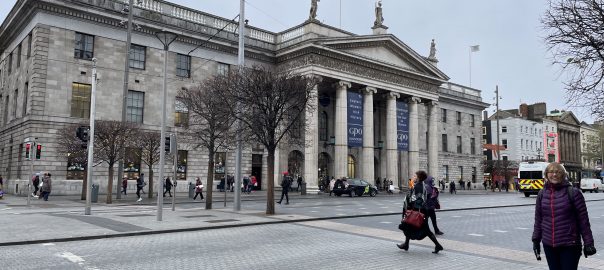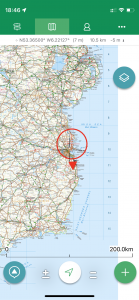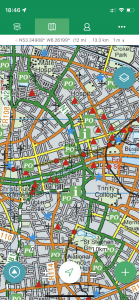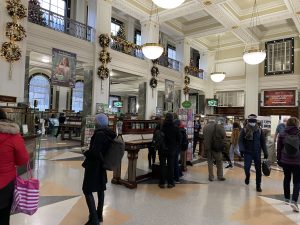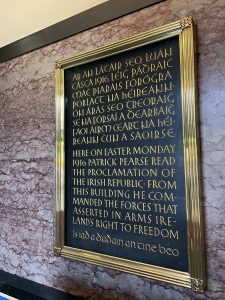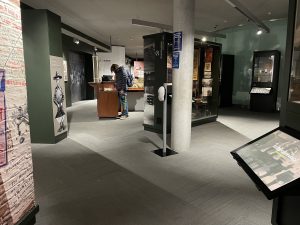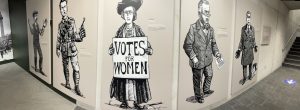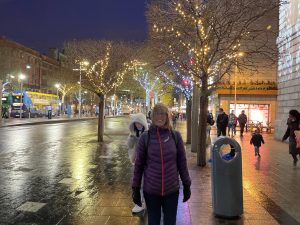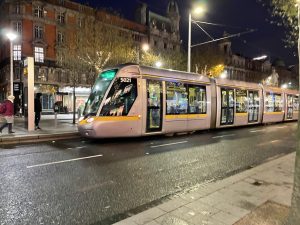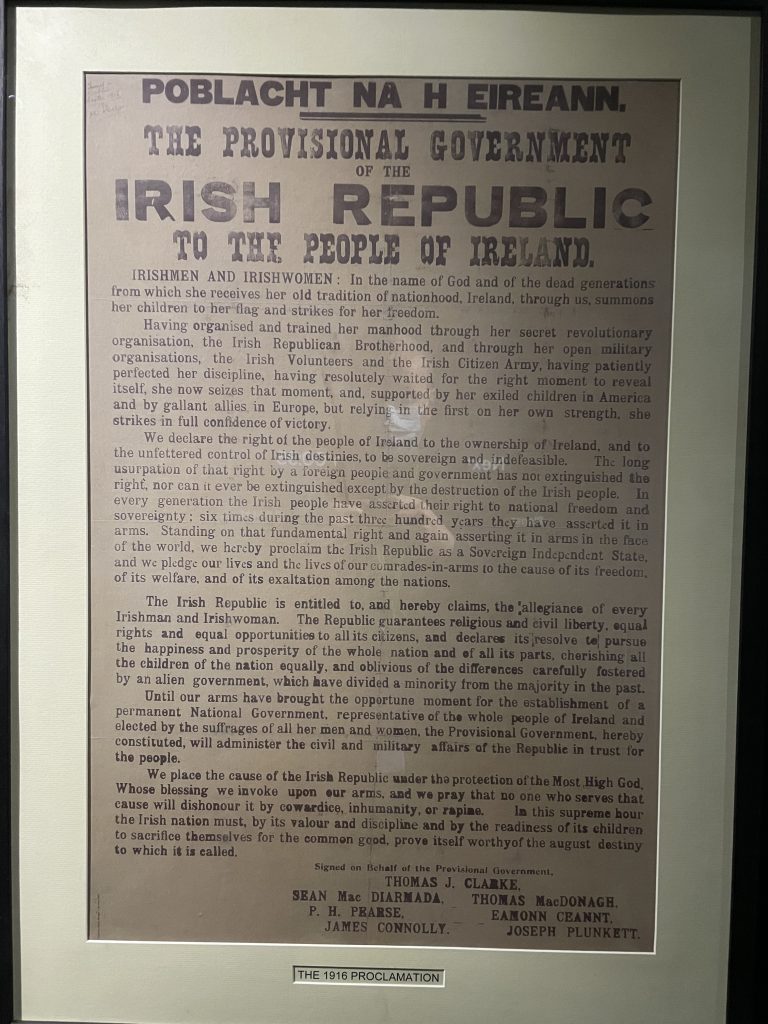Ireland day 0071. Wednesday 08 December 2021- GPO
Commentary
Another history lesson looms today. It’s probably not quite as interesting as the last one, but it does fill in some of the gaps in the history of Ireland in the early 20th century. By all means read it if you want, but if not just skip to the photos and put a note in your diary to visit the GPO in Dublin sometime soon. It’s a small exhibition but totally worth the investment of a couple of hours of you time.
The funny thing about history is that the more you look into it, the more you realise that it isn’t just a simple linear chain of events, where one thing leads to the next, as you are taught at school. Rather, it’s a complex web of circumstances, some big, some trivial which are all interconnected and which shaped the world as we see it today. And the harder you look, the more complicated it becomes. Understanding one layer just reveals more and more layers of complexity beneath.
Today was a case in point.
Ireland this morning was still enjoying the stormy wake of Barra’s passage, so we scrapped our plan for a clifftop work from Bray and decided to opt for an indoor option in Dublin instead. One of the advantages of having a flat so close to the railway station is that we can keep an eye when the trains are running. We had noticed that the trains stopped for a while in the morning – due to a broken power line near Howth Junction, it turned out, – but by lunchtime they were running again so the Dublin plan was back on.
After the Custom House visit on Monday, we decided that we needed to complete – insofar as it’s ever possible to complete these things – our understanding of the events of the 1910s and 20s that led to the creation of modern Ireland. So our obvious destination was the General Post Office on O’Connell St – not because had some letters to post (which we did in fact) but because it was the focus of the Easter 1916 uprising which fired the starting gun – literally and figuratively – for Ireland’s journey to independence.
Our Customs House visit on Monday already led me to write to a detailed post about the history of the various wars that led up to Ireland’s full independence in 1949, so to avoid labouring the point, I won’t go over all that today. Suffice it to say that on Easter Monday 1916, while London was distracted by the Great War, Irish nationalists seized the initiative and stormed the GPO in an attempt to foment a revolution which would eventually force the London government to rescind control of Ireland and yield to the pressure to create a fully independent Republic covering all 32 counties of the island of Ireland.
What I hadn’t really appreciated was the complexity of the forces at play in this uprising. The first thing I didn’t know was that there wasn’t actually a huge amount of popular support for an uprising in the 1910s – many, perhaps even a majority, of the population were happy with the status quo. Especially as, just before the Great War, the prospect of Home Rule for Ireland – a form of watered-down independence – had been dangled by the British Government and which many expected to be back on the table after the war.
The second thing I didn’t realise was that the “nationalists” were not a single movement, rather, a loose grouping of players with broadly similar aims but with quite different views on what the means and end-point should be. The major grouping was the Irish Volunteers with the Irish Republican Brotherhood the minor party. The Volunteers and Brotherhood together planned the attack on the GPO and it was aimed at raising the profile of the nationalist movement with a view to galvanising an unstoppable momentum for independence.
The rebels were armed with weapons supplied by Germany (with whom Britain – which at the time included Ireland – was at war) and the attack was scheduled to happen with 4000 volunteers on Easter Sunday 1916. But shortly before the due date, a shipment of German arms was intercepted, causing the Irish Volunteers to pull out of the attack, leaving the Brotherhood to go alone. They had just 1000 combatants and postponed the attack until the Monday. They successfully stormed and took the GPO and once they had gained control, the rebels, led by Patrick Pearse and James Connolly issued a Proclamation of the Irish Republic, declaring Ireland to be a separate and independent state.
Unsurprisingly, London reacted badly to the attack, seeing it as an act of treachery at a time when the whole country was supposed to be united in a war on Germany. But more profoundly they saw it as a worrying precedent which if successful would be emulated by other domains of the British Empire – Canada, India, the Middle East and more. So in the week that followed the GPO attack, Britain sent in 20,000 troops to crush the uprising. This they successfully did over the next five days, but not before waste had been laid to large swathes of Dublin city centre.
Initially, the public reaction nationalist attack was extremely hostile – the status quo had been disrupted at a time that Ireland was already at war with Germany, and nobody welcomed this home-grown dispute. But as the British intervention was seen as heavy handed and clumsy, public opinion began to change – even over the course of the first week. After the rebels were defeated, some three thousand nationalists were rounded up and interred. The leaders were court-martialled and sixteen of the them were executed. Many of the others were sent to a prison camp at Frongoch in Wales. These actions just stoked anti-British sentiment and were fertile recruitment material for the nationalist cause.
At the time, then, the nationalists’ attack was seen to be a spectacular failure, but over time, it turned out to be a Pyrrhic victory for the British. As a result of the executions, the sixteen came to be seen as nationalist martyrs and pro-independence support grew rapidly. Frongoch became a “University for Nationalism”. These tensions eventually boiled over into the War of Independence from 1919 to 1921 which erupted after Sinn Fein won its spectacular victory in the December 1918 general election. You can read Monday’s blog to see how all that unfolded.
In modern Ireland, the sixteen are still treated as heroes – in 1966, for example, on the 50th anniversary of the uprising, Iarnród Éireann named fifteen of its stations after the executed ringleaders – hence Dublin Connolly and Pearse stations. And the widows and dependents of the rebels were granted war pensions by the Irish government. But you can still sense there’s a slight underlying unease with the circumstances and outcome of the rebellion. Even today there are people who express some reservations, notwithstanding the fact that today Ireland is undoubtedly a very prosperous and relatively safe country. Nobody can ever know what would have happened if the uprising had never occurred, or if the British hadn’t dealt with it so heavy-handedly.
But the whole episode did remind me of just how easily small scale events badly managed can so dramatically galvanise support for populist causes amongst a constituency which, prior to the event, was broadly content with the status quo and had little appetite for change. It’s a lesson that modern day politicians seem reluctant to learn, often to the detriment of everyone involved.
So I’m sorry that this has turned out to be another long history lesson. But it’s as much for my own benefit as anyone else’s and I’m sure I’ll find it useful to look back on and read when I’m a hundred and eight.
But we’re back at the flat now, Barra seems finally to have dispersed, and we’re enjoying a delicious glass of that rather nice SuperValu Chablis and some half price Tesco salmon that was nearing its sell by date. You can’t say we don’t know how to live!
Today’s photos (click to enlarge)
